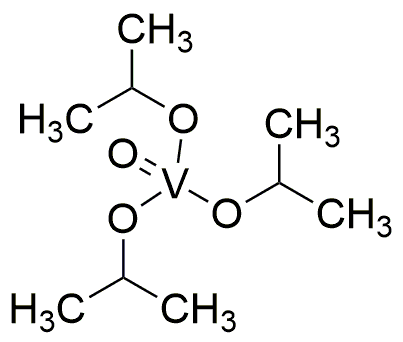Triisopropoxyvanadium(V) oxide is widely utilized in research focused on:
- Catalysis: This compound serves as a catalyst in various chemical reactions, particularly in organic synthesis, enhancing reaction rates and selectivity.
- Materials Science: It is used in the development of advanced materials, including ceramics and composites, where it contributes to improved mechanical properties.
- Environmental Applications: The compound plays a role in environmental remediation processes, helping to remove pollutants from water and soil through catalytic oxidation.
- Electronics: In the electronics industry, it is employed in the fabrication of thin films and coatings, which are essential for the production of semiconductors and photovoltaic cells.
- Biomedical Research: Triisopropoxyvanadium(V) oxide is being explored for its potential in drug delivery systems and as a therapeutic agent due to its unique chemical properties.
General Information
Properties
Safety and Regulations
Applications
Triisopropoxyvanadium(V) oxide is widely utilized in research focused on:
- Catalysis: This compound serves as a catalyst in various chemical reactions, particularly in organic synthesis, enhancing reaction rates and selectivity.
- Materials Science: It is used in the development of advanced materials, including ceramics and composites, where it contributes to improved mechanical properties.
- Environmental Applications: The compound plays a role in environmental remediation processes, helping to remove pollutants from water and soil through catalytic oxidation.
- Electronics: In the electronics industry, it is employed in the fabrication of thin films and coatings, which are essential for the production of semiconductors and photovoltaic cells.
- Biomedical Research: Triisopropoxyvanadium(V) oxide is being explored for its potential in drug delivery systems and as a therapeutic agent due to its unique chemical properties.
Documents
Safety Data Sheets (SDS)
The SDS provides comprehensive safety information on handling, storage, and disposal of the product.
Product Specification (PS)
The PS provides a comprehensive breakdown of the product’s properties, including chemical composition, physical state, purity, and storage requirements. It also details acceptable quality ranges and the product's intended applications.
Certificates of Analysis (COA)
Search for Certificates of Analysis (COA) by entering the products Lot Number. Lot and Batch Numbers can be found on a product’s label following the words ‘Lot’ or ‘Batch’.
*Catalog Number
*Lot Number
Certificates Of Origin (COO)
This COO confirms the country where the product was manufactured, and also details the materials and components used in it and whether it is derived from natural, synthetic, or other specific sources. This certificate may be required for customs, trade, and regulatory compliance.
*Catalog Number
*Lot Number
Safety Data Sheets (SDS)
The SDS provides comprehensive safety information on handling, storage, and disposal of the product.
DownloadProduct Specification (PS)
The PS provides a comprehensive breakdown of the product’s properties, including chemical composition, physical state, purity, and storage requirements. It also details acceptable quality ranges and the product's intended applications.
DownloadCertificates of Analysis (COA)
Search for Certificates of Analysis (COA) by entering the products Lot Number. Lot and Batch Numbers can be found on a product’s label following the words ‘Lot’ or ‘Batch’.
*Catalog Number
*Lot Number
Certificates Of Origin (COO)
This COO confirms the country where the product was manufactured, and also details the materials and components used in it and whether it is derived from natural, synthetic, or other specific sources. This certificate may be required for customs, trade, and regulatory compliance.


